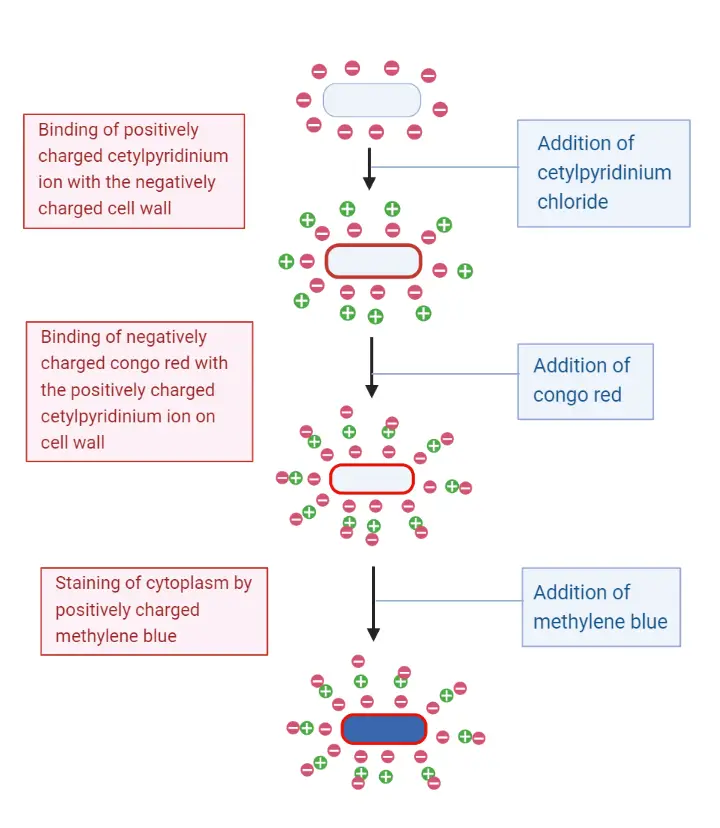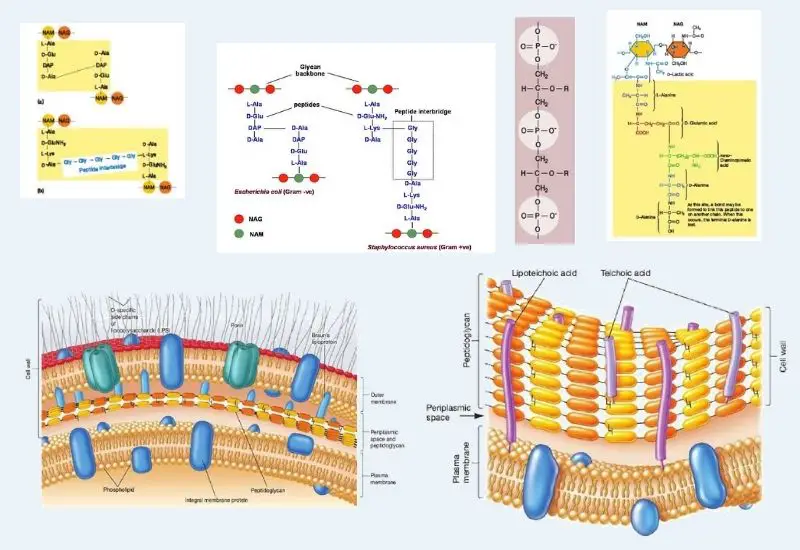Table of Contents
The bacterial cell wall is a rigid structure surrounding the cell membrane. If the bacteria cell wall is removed with the help of digesting enzyme, lysozyme, the remaining portion of the bacterial cell is known as protoplast.
The composition of cell wall varies from species to species, it has been reported that the main constituents of cell wall is chitin, hemicellulose, and cellulose. In addition, prokaryotic cell wall contains peptidoglycan (also known as murein and mucopeptide). Peptidoglycan is mainly composed of sugar, amino acids (peptide; amino acids + glycan; sugar).
The demonstration of bacterial cell wall can be done by using Dayr’s Method.
Objective of Cell Wall Staining
The main purpose of cell wall staining is to identify the cell wall containing bacterial cells and study the detailed morphology of the cell wall.
Principle of Cell Wall Staining
In this method, the bacterial cells are treated with Cetylpyridinium chloride solution. In Cetylpyridinium chloride solution Cetylpyridinium chloride is dissolved in water, where it get ionized and formed positively charged and negatively charged ions.
These positively charged ions of Cetylpyridinium get absorbed by the negatively charged cell wall, as result, the cell wall becomes positively charged. When the cell wall is treated with a acidic dye, the congo red, it will stain the cell by reacting with the positively charged cell wall.
As a result of this reaction, a visible red boundary is developed around the bacterial cell due to the selective deposition of staining reagents on the cell wall. Later the cell is treated with a basic dye like methylene blue, as result, the cytoplasm is appeared as blue.

Requirement
- 24 hours old culture of bacterial cell.
- Aqueous Congo red solution.
- Cetylpyridinium chloride.
- Loeffler’s methylene blue solution.
- Clear glass slide.
- Dropper.
- Inoculating loop.
- Bunsen burner
Cell wall is one of the most essential parts of the bacterial cell, external to the cytoplasmic membrane. A cell wall is…
microbiologynote.com
Procedure of Cell Wall Staining
Slide Preparation and labelling
- Take s clean slide and make is grease free or oil-free by washing it with soap and water.
- Now Air dry the slide and sterilize it by holding it at the blue flame (oxidizing burner flame) of the bunsen burner ( Partially oxidized (yellow) flame would leave deposition of carbon residue on the slide leading to slide blackening).
- Now label the slide by using a glass marker. Label the name of bacteria at the end of slide.
Smear Preparation
- Take an inoculating loop and make it sterile by holding it on the flame of bunsen burner, until it gets hot red. After that allow the loop to cool.
- Now, transfer the bacterial culture on the slide by using this sterile and cooled wire loop.
- Spread the culture on the slide.
- Allow to air dry.
- Heat fix the smear by passing the slide through the burner flame for 2-3 times. It will fix the bacterial cells on the slide. The heating coagulates the cellular proteins as a result the bacterial cell adheres to the glass slide.
Staining Procedure
- Flood the smear with cetylpyridinium chloride (intensifier).
- Placed a few drops of congo red (mordant) on smear previously flooded with cetylpyridinium chloride.
- Gently rotate the slide to mix it properly and allow it to react for 3 min at room temperature.
- Rinse the smear with distilled water.
- Add a few drops of methylene blue over the smear and allow it to react for 10 seconds.
- Wash the slide thoroughly with distilled water.
- Allow it to air dry.
- Now slide is ready to observe under the microscope. Examine the slide under microscope using oil immersion lens (100X).
Result and Interpretation
Cell wall: Appear red boundary around the cytoplasm.
Cytoplasm: Appear in blue color.
Limitation
- Make sure you sterilize the slide at the oxidizing burner flame (blue), because partially oxidized (yellow) flame will leave deposition of carbon residue on the slide leading to slide blackening.
- Avoid making a thick smear, it will result in overlapping of bacterial cells leading to hindrance while microscopic observation.
- Avoid overheating of smear as it can distort the cellular structures and even oxidize the bacterial cells.
- The exposure time for reagents is important as it may lead to inappropriate staining of bacterial cell wall.
- Overexposure of methylene blue may overwhelm the primary colour (red) taken up by the cell wall.
- Add on one drop of oil on slide during oil immersion technique, excess amount of oil may lead to floating vision of smear.
- First focused the smear at 10X objective lens, then 45x and then switch over to 100X to visualize the detailed structural information.
- Clean the microscopic slide before and after the mounting of slide.
- Incomplete drying may lead to floating smear while microscopic observation.
- Exposure time for methylene blue is important as over-exposure makes it hard to distinguish the cell wall and its visibility.
- Cetylpyiridinium chloride stain should be accurately blended with the congo red so that precipitates form at the cell wall.
Reference
- Experiments in Microbiology, Plant Pathology and Biotechnology by K.R. Aneja
- Cell Wall Staining (Dayr’s Method),IIT Bombay, Lab contributed by President Science College
